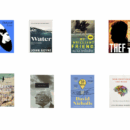To understand success and failure, try visiting the graveyard
“More than two thousand years ago, the Roman orator, belletrist, thinker, Stoic, manipulator-politician, and (usually) virtuous gentleman, Marcus Tullius Cicero, presented the following story. One Diagoras, a nonbeliever in the gods, was shown painted tablets bearing the portraits of some worshippers who prayed, then survived a subsequent shipwreck. The implication was that praying protects you from drowning. Diagoras asked, “Where were the pictures of those who prayed, then drowned?””
NASSIM NICHOLAS TALEB, The Black Swan (2007)
Nassim Nicholas Taleb, iconoclastic author of The Black Swan, wants you to spend more time in graveyards. Not literally – though that is also not a bad thing, in that it may be good therapy for those of us who doubt our own mortality. A visit to a funeral or a cemetery always has the invigorating effect on me of renewed urgency to do all the things I have to before my own obituary is written.
But Taleb is referring to something else: the problem of silent evidence. As Cicero pointed out, we all suffer from ‘survivorship bias’: that is, we confine our evidence to that adduced from those few who succeed or survive, and ignore the silent evidence of all those who didn’t make it. The graveyard is silent, the awards ceremony is noisy.
We avoid looking at the vast silent cemetery around us, and pay deep attention to success stories. Taleb points out that drowned worshippers do not write histories of their experiences, and so it is with losers in history, whether people or ideas. People who fail do not often write memoirs, and if they did they would not be published. And so the learning that could come to us from the accounts of those who didn’t succeed is lost.
What nearly every writer, journalist or historian does is work backwards from success. Only the population of achievers is considered worthy of analysis: people who have big titles and big money. This population is studied and, lo and behold, some common attributes emerge. Successful millionaires are often found to be risk-takers, inherently optimistic, and deeply courageous. The inference is that these are the traits of success, and will help you, too, become rich and successful.
But we have failed to look at the cemetery. Taleb tells us that the graveyard of failed persons will also be full of people who had the following traits: risk-taking, optimism, courage – just like the millionaires. Indeed, for many of the failed ones, their tendency to take bold risks is what undid them. This is not to deny the role of skill, or hard work, or other factors that might distinguish the successful from the failed. The point is that it’s not as simple as that. When we consider that the same things can cause failure just as easily as they cause success, we are left wondering at the role of luck, pure and simple, in our lives.
Here in Kenya, we are even more extreme in avoiding the cemetery. We adore pretty much anyone who has a big car and big house, unquestioningly. We know very well that some of the successful characters we observe are both lazy and dissolute, and that even luck does not explain their success. But we ignore the line of causality completely. It doesn’t seem to matter HOW you succeed; the point is to succeed, full stop.
We must stop being so narrow-minded and so simple-minded about success and failure. They are just the opposite sides of the same coin, and lady luck can visit either upon us. When you next read the autobiography of some important personage, or ask for tips from a successful personality, be more circumspect. If hard work, courage or optimism are all it takes, there should be far fewer people in the cemetery of failed persons.

Buy Sunny Bindra's new book
The X in CX
here »
Popular Posts
- My books of the yearDecember 14, 2025
- Confessions of an explaining personDecember 7, 2025
- Here’s why you should become foolishNovember 30, 2025
- How to listen, really listenNovember 16, 2025
- Is AI hiring your company into oblivion?November 23, 2025











